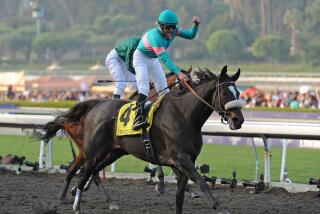This guy knows how to calm jittery stars
- Share via
Steve Martin
Wild animal trainer
Current project: The family film “Racing Stripes,” about a plucky zebra (voiced by Frankie Muniz) that becomes a racehorse. (Hayden Panettiere and Bruce Greenwood are the two-legged stars.)
Challenge: Training a group of wild zebras to play the zebra called Stripes.
Credits: The 1960s TV series “Daktari,” “Dances With Wolves,” “The Bear.” “We have an exotic animal ranch here in California, Working Wildlife. We have bears, lions, tigers, all types of birds of prey, reptiles. We have a variety of animals. Most of the animals are bred in captivity these days. We have probably 150 animals.”
Horse in striped pajamas: “Zebras are not considered domesticated animals. People look at them and see them as horses, but they aren’t. They are more flighty and nervous and quick-moving. There is more to them than a horse. We have trained them for commercials and bit spots in movies, but this whole movie is about zebras. So from start to finish we had zebra work through the whole movie.”
Let the race begin: “The movie was kind of a last-minute thing for us. We got called in on a Monday and we left on a Saturday. They gave us a script and a storyboard background for the shots and then, when we went over to South Africa, we started collecting up zebras. For about a month, we started collecting one here and one there we thought would work out.”
Zebra quest: “They were on big ranches and big farms. Most all of them are wild. We had four babies, and I think we had seven adults. They were pretty close [in appearance]. We didn’t end up doing any real makeup jobs on them, but a couple of them we had to trim their mane a little bit to make them the same length as each other.”
Training sessions: “We prepped for four months and then we shot for four months. We were starting from scratch with these zebras. We had to halter break them -- that means putting a halter on their head and having them get used to that, and then to being led and [our] making them lead. For the riding, there was a whole process to that. You get a towel and put it on their back and then brush it up their legs, so you get them used to anything touching them, which takes time. You finally put a pad on them and put a little cinch strap on them. We also put a little harness on them and had them pull a tire to get them used to feeling stuff pulling on them.
“There are a million little things you do before finally putting someone on the zebra. The first time somebody was riding the zebra it was actually being ridden right next to a horse. If you hook them up to a horse, they become buddies. We did some shots actually using zebras racing with the horses and then we had a couple of horses made up to look like zebras because when you are trying to do out-and-out runs with thoroughbreds, these guys aren’t as fast.”
Spare the rod: “If you try to be too hard on them or too quick, they want to run away from you. So you want to build up their confidence. You have got to be fair with them. You try not to use too much food. We use more praise. It’s like teaching them to stand on a mark. When you teach them that, as soon as they’ve got it, you back off and let them alone. They knew the mark was their safe place.”
Stripes of character: “They all had different personalties. We had our main ride zebra, which was Sammy, and then we had a stunt zebra, Schuster, who was very friendly and very nice. Hayden did a lot of stuff with Schuster, where she had to hug him and kiss him and ride a motorcycle right in front of him. He was a pretty stable animal, pretty tame.”
Zebra 101: “We had sessions [with Hayden and the zebras] almost every day for an hour or hour and a half. We showed her what you could or could not do it. You don’t want to run up to them and jerk on their halter. That is an obvious thing you couldn’t do. You wouldn’t want be around their back because sometimes they kick.”
Aftermath: “All of them went back to their original homes. Some of the places we got them were thousands of acres, so they just went out with other zebras on the home range. When we took them back, they just walked out of the trailer and started munching grass. It was like they had never left.”
More to Read
Sign up for The Wild
We’ll help you find the best places to hike, bike and run, as well as the perfect silent spots for meditation and yoga.
You may occasionally receive promotional content from the Los Angeles Times.







